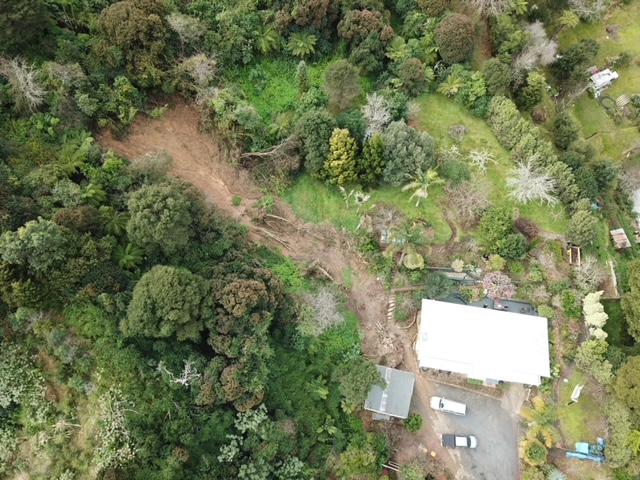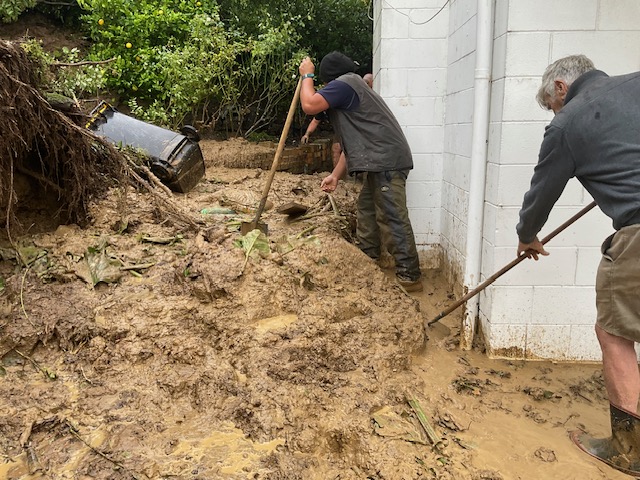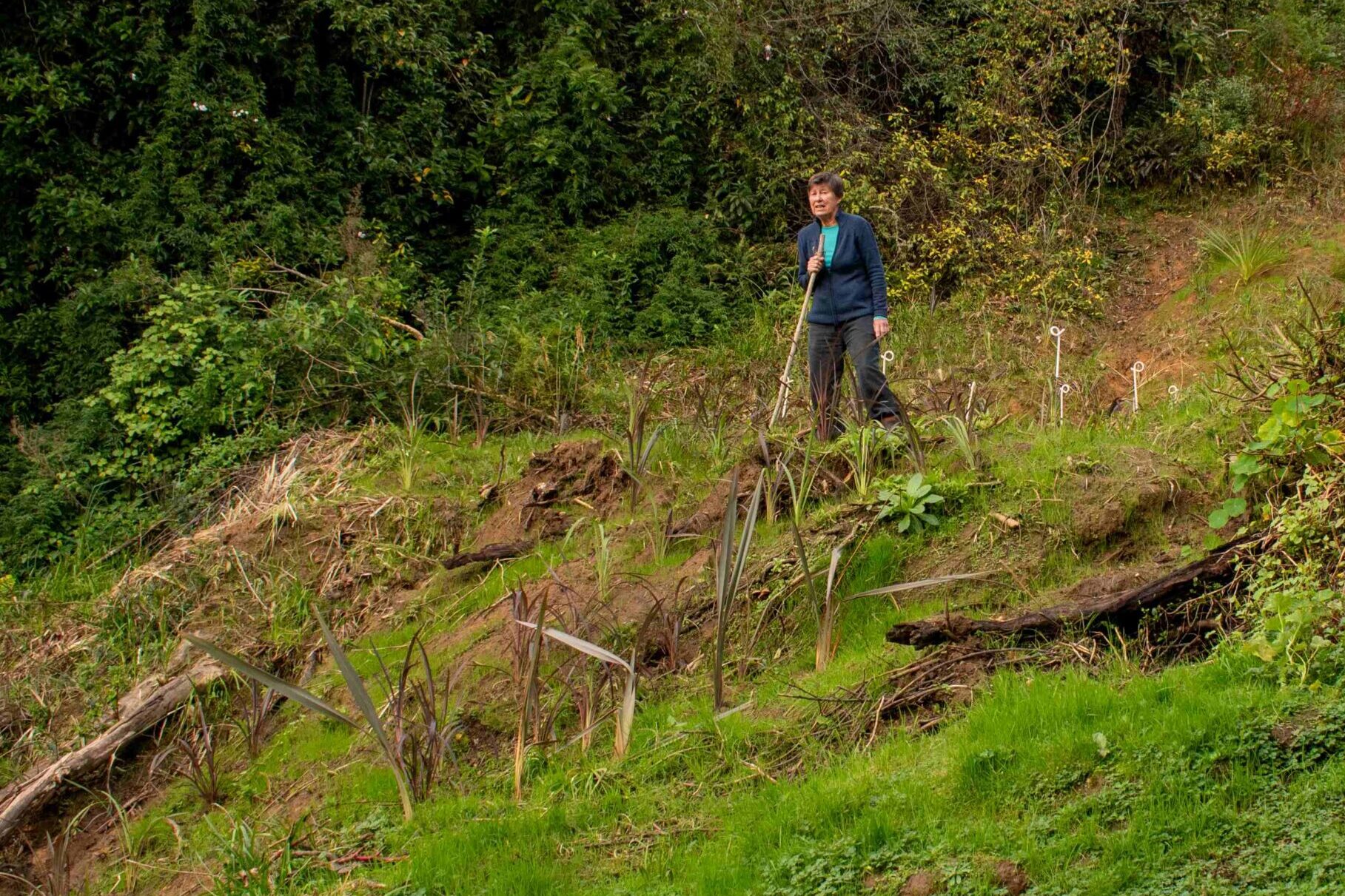The Profile’s investigation into storm-damaged homes continues with a look at a Thames property facing extensive remediation costs. ALICE PARMINTER reports
A 17-month old slip from Department of Conservation-owned land has left Thames homeowner Paula Wallis with a problem she can’t afford to fix, and her attempts to reach a resolution which won’t leave her in financial ruin have been “a nightmare”.
Paula’s home was flooded with debris on February 14, 2023, when Cyclone Gabrielle hit the peninsula. Up to 120 tonnes of debris slipped from the hillside above her property, washing down her driveway and onto Upper Albert St.
The 80-metre slip was stopped in its tracks by Paula’s garage and the corner of her home.
“It came down at four o’clock in the morning, and the noise was absolutely appalling,” Paula said.
“A huge privet sort of went through the garage wall, and the slip was stopped, obviously, by that wall of the garage, and the back wall of the garage, and this wall of the house… There was water up to windowsills.”
Paula’s house initially received a red placard from Thames Coromandel District Council (TCDC). However, while the garage was heavily damaged, the home appeared to be unharmed apart from dampness caused by slip water sitting against the concrete wall of the ground floor. The property was reallocated with a yellow placard in the days following the storm, allowing her restricted access to the main dwelling.
She has since been issued a remediation report from the former Earthquake Commission (EQC), now known as the Natural Hazards Commission. The report required her to build a retaining wall at the edge of her property to prevent further slips. The fix will cost an estimated $659,000, which is more than double the value of her property.

Like many others across the country, Paula has spent the months since the storms filing insurance and EQC claims, and trying to repair the damage to her property.
“I’ve been trying to deal with DOC, TCDC, EQC, and really it’s been an absolute nightmare beyond imagination,” she said.
The slip came from the hillside above her property, which is owned by DOC. Paula said she “naively” thought the organisation would have some responsibility to repair the damage.
“I thought it’s their debris, they will pick up responsibility. They’ll repair the damage and they’ll assess the stability of their land above my property,” she said.
“They sent me such a blah, nonsensical response that said ‘many people have been badly affected. We’ll await EQC taking control of everything and we’re not going to do anything.’”
DOC’s Hauraki operations manager Avi Holzapfel said the organisation was not legally liable for situations where a natural event has caused damage to private property, saying it was the responsibility of landowners to understand the potential risks involved in purchasing such land.
“These situations can be complex and difficult,” Avi said.
“The issue of land instability [at Paula’s property] is not limited to public conservation land but also includes private land.
“DOC will not be making any payments toward remediation of this property… We sympathise with the landowner’s situation, but any resource we directed to this situation would take away from core conservation work.”
Avi said DOC did assist Paula with the clean-up “on the basis of being a good neighbour”.
“We sent a team of five or six staff – with two vehicles and trailers – to the property to assist. Based on a previous exchange of emails and agreement made with the resident, our staff removed piles of vegetation the resident had accumulated. We made clear our agreeing to clear the vegetation was not an admission of DOC’s liability for the damage. The resident emailed us after the job to thank us for the work done.”
Paula said DOC “finally took away a couple of trailer loads. But that doesn’t quite measure up to the 120 tonnes”.

Six months ago, Paula also demolished the damaged garage. So when TCDC renewed the yellow placard on June 13, she was surprised to see the garage was still listed on it.
“A woman from the council turned up with a new yellow sticker and I thought, gosh, this will be interesting. They must have noticed that a lot of work’s been done,” Paula said.
“And I read the sticker… it had on it ‘garage, do not enter or use’.”
The yellow placard describes the property as a “garage – debris flow heavily damaged”, alongside the main dwelling.
In a statement, TCDC said the placard was replaced as it had become unreadable, and the demolished garage was noted at that time. However, the wording was left the same “as the owner has indicated she may rebuild” on the same platform. Council said the placard could be amended to omit the garage if the owner wished, as the point of the placard was to inform the occupants of the risks on site.
Paula said the lack of care around the placard’s wording was indicative of the insufficient communication and help she felt she had received from the council.
TCDC staff visited the site in the weeks following the storm, and Paula said she has had three visits from a social navigator tasked with supporting property owners working through the EQC process. However, she said the “wrap-around support” council said it offered in a previous Profile article had not been her experience.
The council wouldn’t comment on the specifics of the assistance offered to Paula, but said it involved “multiple visits to the property, texts, phone calls and emails over more than a year”.
“Information and advice as to what steps needed to be taken to progress claims with insurance and EQC was provided, potential council rates remissions were identified, contacts with social and mental health service providers were made available, and council staff contacted EQC and insurance companies on behalf of property owners,” the statement said.
Paula was also disappointed to find she was not able to sell the property under the government’s Future of Severely Affected Locations (FOSAL) buy-out programme. However, the council noted “no properties in our district have met the criteria for buy-outs” under the FOSAL scheme.
“Once the slip area is remediated, as per an engineer’s report requirements, council will be able to lift the placard,” the statement said.

Paula’s attempts to seek help through the Earthquake Commission, now known as the Natural Hazards Commission, were also unhelpful, she said.
“The [EQC] land remediation actual cost was estimated at $659,000. And their offer was $70,000,” Paula said.
“I’ve got to comply with what EQC remediation is… the bulk of this $659,000 is really to build a massive wall with poles spaced one metre apart. The poles have got to be 8.5 metres high. And this wall is, put simply, to prop up DOC land.”
EQC Toka Tū Ake chief executive Tina Mitchell said EQC contributions were calculated on the market value or the cost of repairing a portion of land, up to a cap.
“EQCover provides a limited financial contribution for certain areas of damaged land under and up to eight metres around a home and some related buildings, as well as some defined land under their main accessway up to 60 metres from their home,” Tina said.
Paula said the $589,000 shortfall in funding was putting her in an “impossible situation”, and she took issue with being asked to do $659,000 worth of remediation on land that has a current capital value (CV) of $310,000.
“[It’s] a pretty harsh punishment for someone else’s land falling on top of me, isn’t it?” she said. “But it certainly seems, having been through the system, as though the whole mechanism of the EQC Act is set up to ensure that true remediation costs will not be paid. Because, really, most slips don’t start eight metres from your house.”
Tina Mitchell said the EQC Act, and the new Natural Hazards Insurance Act, which replaced the EQC Act on July 1, provide only limited coverage for land as a buffer against extreme natural hazards.
“It is rare globally for damage to land to be covered by insurance. In New Zealand, the scheme does provide some limited coverage for land… one of the only schemes in the world to do so,” she said.
“The new Act was intended as a modernisation of the legislation based on the lessons from the Canterbury earthquakes. It did not involve a fundamental review of the hazards covered by the scheme. The level of cover provided and the level of risk accepted by homeowners therefore remains the same.”
Since the storm, Paula has done her best to mitigate future slips on her property. She has planted around 200 plants near the top of the slip. Further down, she’s installed a drainage system with erosion drainage fabric and rocks, which she says has redirected water flow away from the house.
“But, as I said, I’m stuck because I haven’t done what I should have done,” she said.
“I think the drainage issues have been totally resolved. However, I would have to get a geotech structural report that would cost me [another] $70,000. And of course there’s no guarantee that they’ll accept it.
“The consequences for me financially are ruinous. I can‘t afford to sell because I‘d be lucky to get even 20 per cent of what the property is worth… I‘ve become a prisoner in my own house. I‘ve exhausted all attempts to get DOC, EQC or TCDC to do anything to help me out of this situation with zero response.
“People like me are really left with very few options.”





